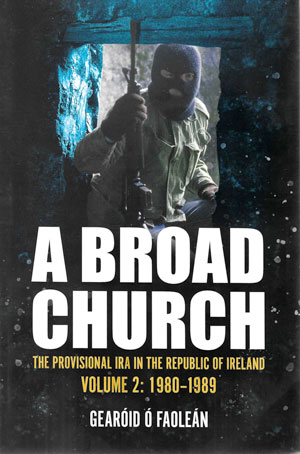
GEARÓID Ó FAOLEÁN
Merrion Press
ISBN 9781785374456
€19.99
Reviewed By Niall Meehan
Niall Meehan is the retired head of Griffith College’s Journalism and Media Faculty.
Volume 1 of Broad church was Gearóid Ó Faoleán’s path-breaking Ph.D-based analysis of the base of southern support for the Provisional IRA during the 1970s. Volume 2 takes us through to 1989.
An abiding difficulty with writing this history is that, whereas talking about the 1919–23 period might earn a participant a medal, a pension and, indeed, acclaim, speaking about IRA activities in the more recent period can still result in a prison sentence. The conflict, whose violent phase ended for the IRA in 1997, is not over.
Historians are hamstrung. Unless former activists refer to events for which they were already incarcerated, they are less likely to speak. Not the least of their concerns, even if personally indifferent, is for others who might be implicated. Those more apt to talk may have something to get off their chest and/or a gripe about others in the movement. A rounded picture may be difficult to obtain.
After unwise publication of narratives from the controversial Boston College Archive, and the PSNI’s successful US court application to obtain testimonies, former activists became wary. When the Irish Bureau of Military History took 1916–21 testimonies in the 1940s and 1950s (released in 2003), the integrity of the process was accepted generally. No such agency exists today or is likely to exist in the foreseeable future. That has negative consequences for attempts to unravel a long-running conflict suffused with disinformation and media manipulation.
Given these difficulties, as with Volume 1, Ó Faoleán has assembled a wide range of archival and published sources. Original material includes a tape recording and eighteen interviews, six of which are anonymous. Interspersed within the narrative are newspaper accounts of court cases involving republican suspects. Tables list official seizures of arms and explosives for the 1980s. But this is not simply a blow-by-blow account of IRA actions south of the border in support of the northern conflict. The underlying political context is outlined. He demonstrates how armed support was maintained over three decades in spite of political and counter-subversive suppression from State agencies, in addition to media hostility and censorship.
The State’s methods in suppressing IRA activities, which morphed into a wider political suppression that included broadcasting censorship, certainly hampered armed activity. What it did not do was end it. The broad base of IRA logistical support included extensive arms importation, bomb-making and armed robberies. It also included breaches of IRA Order No. 8, prohibiting confrontations with southern State forces, leading to sometimes-fatal results. Armed-conflict purists, cited by Ó Faoleán, considered political activities, even the hunger-strike solidarity movement, a distraction from ‘the War’. Political intervention in fact saved the struggle from late 1970s marginalisation, consequent on indifference to broad-based political participation.
Ó Faoleán details how Garda harassment and beatings increased as republicans entered the political arena during and after the 1980– 1 H-Block hunger-strike crisis. ‘Heavy gang’ allegations did not conclude with the 1970s Cosgrave–Cooney–O’Brien, Fine Gael–Labour, coalition. Beatings intensified during the 1980s, intended to suppress in the South any replication of northern Sinn Féin electoral support. Ó Faoleán’s figures on misuse of the Offences Against the State Act indicate how it was used to detain republicans engaged in politics. Uninvolved relatives of IRA suspects were targeted too, and Ó Faoleán notes claims of harassment by campaigners on behalf of the Birmingham Six.
If republican complaints were routine, they emerged also from a new source, inner-city working-class communities attempting to drive out drug-pushers distributing cheap heroin. Republican involvement with the Concerned Parents Against Drugs movement excited Garda authority, which severely oppressed those confronting the drugs menace, more so than those causing it. Allegations of RTÉ censorship also attracted a wider audience after a controversial 1983 Today Tonight programme on the drugs menace seemed to smear republican activists. Ó Faoleán cites Andre Lyder’s participant account, Pushers out, which comprehensively narrates these extraordinary episodes. He pointed to an eventual Garda revolt, at lower levels, in the face of increasing hostility from whole communities.
When wider layers of the southern population, though a minority, became engaged politically with the North on a sustained basis, their experience of censorship and repression hardened the determination of many to stay the course. It undermined the legitimacy of the southern State that said its actions were based on the illegitimacy of IRA activity. As the State’s strategy spread to inner-city areas, already a base of republican support, more became estranged from official northern policy. H-Block marchers and their successors were more politically committed than higher numbers on anti-tax demonstrations, a false comparison cited by Ó Faoleán.
Ó Faoleán deals judiciously with disputed events, not least inflated and contradictory claims from the informer Seán O’Callaghan. Volume 2, like Volume 1, of Broad church is essential reading on the IRA in the South in the 1970s and ’80s.
